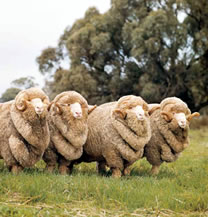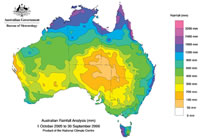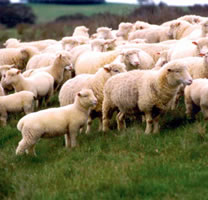Prime Lamb Production
While the Australian wool industry enjoys a high international profile, there is also a significant trade from Australia in sheep meat products derived from wool industry sheep. The lesser known Australian sheep meat industry is equally committed to excellence and is producing consistently high quality product which is the equal of any in the world. Lambs bred and grown specifically for their meat (known as prime lambs) form the cornerstone of the industry. The high quality lean meat produced from these lambs is in high demand both domestically and internationally.
In developing prime lambs, Merino ewes are usually mated to long wool Border Leicester rams to arrive at a first-cross ewe. First-cross ewes are then mated to short wool meat breeds, such as the Poll Dorset or Suffolk breeds, to arrive at the Australian prime lamb. These first-cross ewes and their progeny comprise around 12% or more of the Australian sheep flock. Around 9% of the Australian flock is Merino-derived dual-purpose breeds, bred in higher rainfall areas to produce both wool and a more acceptable carcase than that supplied by the Merino. Such breeds include the Corriedale, Polwarth and Comeback.
The remaining 4-5% is predominantly British breeds, both long and short-wool varieties, whose role it is to produce terminal sires for the crossbreeding sector of the industry. There are also Middle Eastern and African fat tail sheep breeds, maintained for the livestock export industry, as well as several European sheep meat breeds.

Captain John Macarthur, regarded as the father of the Australian sheep industry, first developed a flock based initially on British rams and Indian ewes shipped from South Africa to Camden near Sydney in 1797. Later, he introduced Negrette sheep of Spanish Merino type from England. These original sheep were small and did not produce much wool. The average greasy wool weight was then around 1.8kg per head. However, with the application of superior breeding and production methods, production from today’s Merino almost triples that of these early Merinos.
The Saxon strain was first imported into Tasmania from Saxony in 1830. The breed was developed as a producer of fine wool and most of the fine and superfine flocks in Australia are based on this strain. The Peppin Brothers of Wanganella Station in New South Wales developed the Peppin strain in the 1860s. This strain incorporates the most desirable characteristics of Saxon, Rambouillet and Vermont Merinos. The Peppin strain flourished in the hot inland areas and provided the basis for the medium-wool Merino, the most common type of Merino in Australia. The South Australian strain evolved from similar breeding to the Peppin, but with an emphasis on a larger body size, strong wool fibres and the ability to survive in harsh, dry areas.
First reports in Australia of British meat breeds were of Cheviot and English Leicester sheep imported to Tasmania in 1829. Later, in 1839 Border Leicester and Dorset Horn breeds were introduced to the mainland.
The prime lamb industry comprises approximately 4 million purebred Merino lambs, 8 million 1st cross lambs (either terminal or maternal sire x Merino) and 6 million 2nd cross (terminal x 1st cross ewe).
The traditional production of first-cross Border Leicester/Merino ewes has become an important industry segment.
Other breeds such as the Finn, East Friesian, Coopworth, Dohne, Samm and maternal composites are also becoming popular as sires for this first-cross breeding segment. An estimated 12 million first-cross ewes are mated annually to ‘terminal’ sires from a third, short-wool breed. This produces fast growing, large, lean prime lambs for both the domestic and export markets.
Poll Dorset the most common terminal sire breed, with Dorset, Suffolk, White Suffolk and Texel also being used. The Wiltshire Horn, South Suffolk, Cheviot, Ryeland, Shropshire, Lincoln and Southdown breeds are used to a lesser degree.

Prime lamb production requires fast, uninterrupted growth achieved in the improved pasture, higher rainfall areas of southern and eastern Australia. New South Wales’ tablelands and slopes regions, Victoria, south-east South Australia, south-west Western Australia and Tasmania are the major areas for prime lamb production in Australia.
An increasing focus is being given to strategic finishing, or lot feeding of lambs. The aim is to produce consistent carcases that are large and relatively lean for sale in the domestic and export markets.
